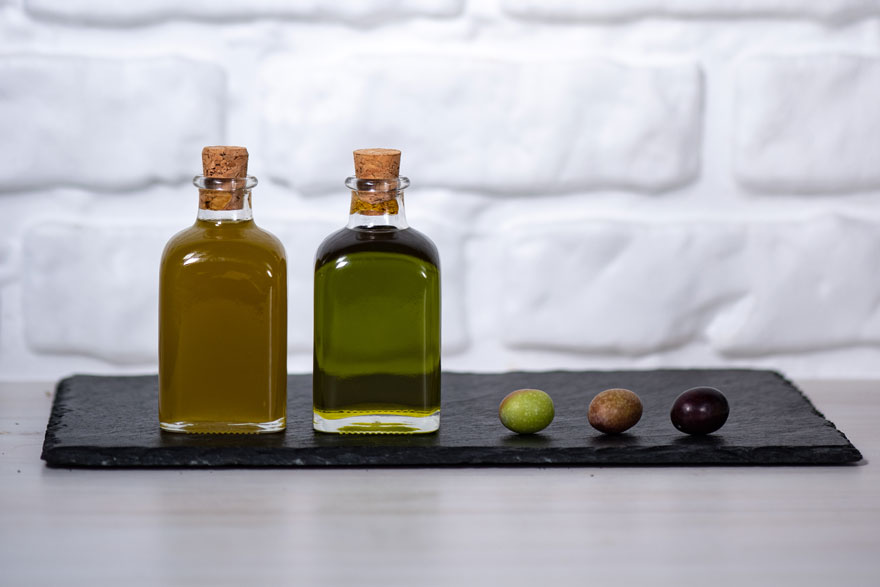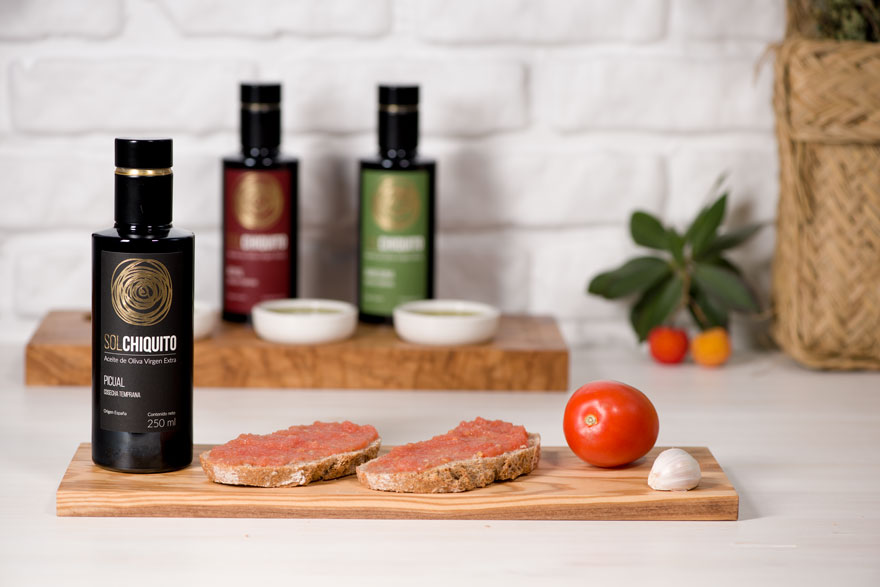


Filtered or unfiltered?
10 February, 2021How to make a healthy toast


One of the mediterranean breakfasts main carácter is the toast with tomatoe and extra virgin olive oil, that in some houses are accompanied by raw garlic scrubed over the toast. We want to give you some useful advices to prepare the toast in the healthier way.
¿Brown or White bread?
The difference between the White and Brown bread are that while the White bread is elaborate with refined flours, the Brown bread is elaborated with wholemeal flour that preserve the bran and germ appart from the endosperm. This presents many advantages:
- More fiber content which facilitates the digestive function improving the intestinal transit and the nutrient absorption.
- Higher vitamins quality from group B, that have a essential function in the cell metabolism and the energetic processes of the organism.
- Greater mineral contribution, specially magnesium which ingestion is fundamental among other things to mantain the bones healthy and strong.
- Lower caloric intake tan the White bread, around at least 7%.
Lower glucaemic index that is in consonance with the conclutions of big epidemiological studies such as “Relationship between bread and obesity” which ends with the conclusión: “…within the framework of a meditarranean style diet, the reduction of white bread but noto f brown bread, was associated to less weight and abdominal fat gain “.
Because all this we recommend the toast to be of Brown bread and to assure that it is really elaborated with wholemeal flours as not everything that seems to be Brown bread trully is. Be aware that the official definition of wholemeal flour is the grain miling integrated cereal resulting product.
Toast the bread just the right time
The food that contain starch and that are cooked at high temperaturas over 120ºC and in low humidity conditions produce acrylamide. Following the regulation (UE) 2017/2158, “hte acrylamide present in the food can increase the risk of suffering cancer for the consumersof every age group”. Because fo this is advisable that the tosting time of the bread is the mínimum needed to the toast to acquire the needed consistency and a light Golden colouring without getting burned.
Within the Brown breads choose those which have been submitted to a higher fermentation period; more fermentation time requires less cooking time and therefore less possibility that the bread contains acrylamide.
¿With or without garlic?
In some houses is costum to scrub a raw garlic on the toast before putting the oil anf tomatoe. From a hedonic point of view using or no garlic is a matter of taste. However from the heath point of view, the raw garlic use in toasts confer a Benefit due to specially the substance called allicin.
The allicin is a sulfur substance with interesting pharmacological properties that is produced from the alliin when it comes into contact with the enzyme allinase. Both substances, alliin andallinase are saved separately in the garlic and just when a damage is produced in its tissues these compounds mix to form allicin, that is in charge of protectin the garlic from fungus, bacterias, insects and small mammals; a curious method of chemical defence.
As the allinase degrades with the heat effect we can only benefit from the garlic properties if we eat it raw however some studies say that wcecan keep the medicinalproperties of the gralic if you chop it and let it rest for 10 minutes before cooking.
We extend this same recommendation for the garlic in the toasts. If we cut it and we leave it a few minutes before scrubbing on the toast we will give time to the allinase enzyme to transform the alliin to allycine which consumption stimulates the immune system, reduces the blood pressure, cholesterol and triglycerids, and have antioxidant effect.
The benefits of the tomato
The tomato owes its red colour to a carotenoid called lycopene. This substance has antioxidant properties and because of this it protects the cells from the oxidative damage produced by the free radicals, responsable for the cardiovascular diseases, cancer and the aging.
A growing number of studies suggest that the inclusion of the tomato in the diet and therefore the lycopene consuption, is related with the lower incidence of patologies related with the aging, cardiovasculars and cancerous, like the lung, prostate and digestive tract cancer.
The lycopene quantity that the tomatoes have vary according to various factors:
- The cultivation system. It has been proved that the tomatoes grown outdoors have higher lycopene content to those grown in greenhouses.
- The tomato madurity degree. The tomato ows its red colour to the lycopene, so they will have more lycopene content as more mature the fruit is. It has been proved that the tomatoes that mature in the tree have more quantity of this carotenoid than the ones who mature after being collected.
- The tomato variety. Not all the tomato varieties present the same lycopen content. One of the varieties that more lycopene present is the pear tomato that can have up to 10 times more quantity than the salad tomatoes.
Now we have in our kitchen a pear tomato, very red and coming from outdoor cultivation. But ¿how do we use it on the toast? Is frequent to see how once the bread is toasted firstly we put de oil then we scrub the tomato; it is not the most appropiate. To understand this point we have to make two observations:
- The more lycopene quantity is concéntrate in the tomato peel. If we cut a tomato by its half and then we scrub i ton the bread we are not taking advantage of the peel and therefore we are wasting an important amount of lycopene. Is much more advisable to grate the tomato or whisk it to take full advantage of it.
- The lycopene is a watersoluble substance. This means that the lycopene dissolve oin oil. Therefore if we mix the grated tomato with the extra virgin olive oil or we whisk the oil and the tomato together we are facilitating the transfer of the lycopene to the fat and its subsequent assimilation by our organism.
Our recommendation once the tomato is grated is to pour the extra virgin olive oil amount you deem convenient and mix it. Or better, whisk the tomato with the oil. You can keep it in the fridge and use it in different days on your toasts. In this way you will take much more advantage of the lycopene and you will enhance its healthy effects.
The extra virgin olive oil, the King of the mediterranean diet.
If we talk about health benefits, the indisputable main carácter of a healthy toast is with no doubts the extra vigin olive oil. Many studies point out the multiples advantages that carry the inclusion of the EVOO in our diet.
We analyse the two fundamental pillars that make the EVOO so healthy: high oleic acid content and its phenolic composition.
The oleic acid is the main fatty acid in the olive oil and it presents around the 80% of the fatty acids of its components. In a monounsaturated fatty acid and its inclusion on the diet are atributted multiple benefits for the health, among others:
- Reduction of the low density lipoproteins (LDL) and increase of the high density lipoproteins (HDL).
- Cardiovascular diseases prevention.
- Blood pressure reduction.
- More lymphocites’ development and acitvity, increasing the immune defenses.
The polyphenols are a minority fraction of the extra virgin olive oil but they provide huge benefits for people’s health. This healthy action is based fundamentally in the antioxidant action that the polyphenols in the EVOO make. The Regulation (UE) Nº 432/2012 from 16 of may 2012 Commission where is established an authoryzed declarations list of the different food healthy properties related to the risk of disease reduction and to the developement and child health, includes the next statement: The polyphenols in the olive oil contributes to the blood’s lipids protection against the oxidative damage. This statement can only be used when it comes to an olive oil that contents at least 5mg of hydroxytyrosol and its derivatives (for example, an oleuropeurin or tyrosol complex) for each 20g of olive oil. For a product to be able to carry this statement it will be informed to the consumer that the beneficial effect is obtained with a diary ingestion of 20g of olive oil. A diary ingestión of 20g involves an anual consumption of 8 litres of EVOO with the same polyphenols content than the one indicated in the regulation (250mg/kg) so we can assure this healthy effect, or 4 litres in case that the content is the double of the established mínimum (500mg/kg)
Many are the benefits that the diferent polyphenols add (hydroxytyrosol, tyrosol, oleuropein, oleocanthal, …) that we will develop later in a specific article. By now we just indicate you that the polyphenols content in the EVOO depends on factors such as the olive variety, the sanitary state of the olive, the cultivation’s hydric regimen, the altitude where the plantation is located, the olive extraction temperature, etc.
Controlling all these factors we can produce oils with a higher phenolic content and we, who manage these variables in our Sol Chiquito EVOOs’ elaboration process, recommend you to use, from our range of oils, the early harvest Sol Chiquito picual or the early harvest Sol Chiquito Altofenol ecological picual.




